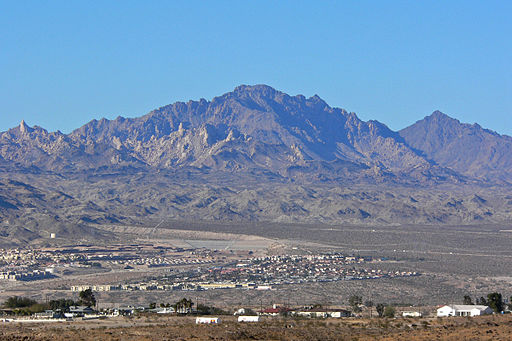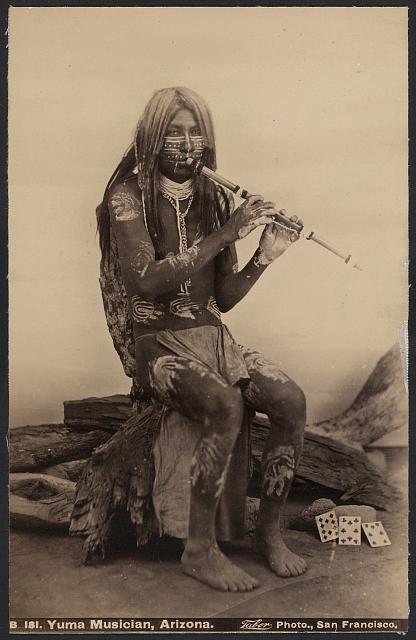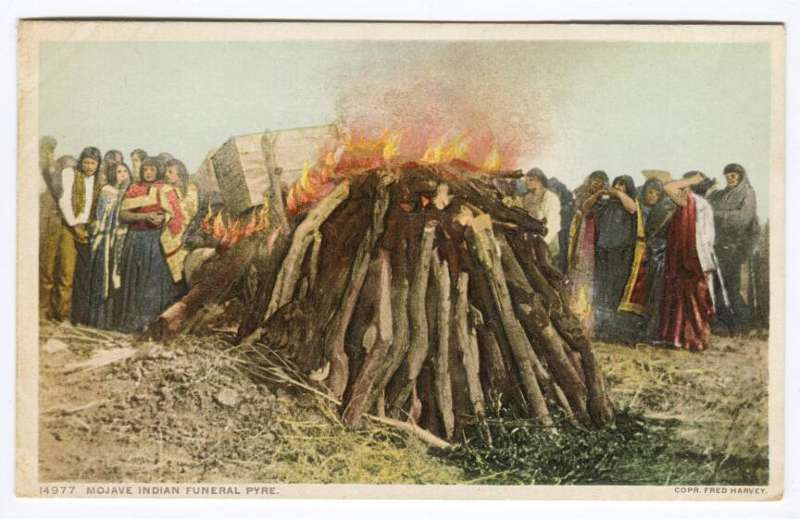Origin Beliefs
The world was brought into being when Sky and Earth gave birth to a child, Matavilya, who built the sacred Great Dark House where Mojave dreamers would later come to receive their power. After offending his daughter, Matavilya was killed and cremated and the Great Dark House was burned. Leadership then was assumed by the diety Mastamhό, who proceeded to bring shape to the land. He also created the Colorado River and the people, who he separated into different clans and tribes, and created the sacred mountain Avikame (commonly known as Spirit Mountain) where all future unborn souls lived. It was at there at Spirit Mountain that Mastamhό assigned special powers and talents to those souls destined to have leadership roles in Mojave society.
Spirit Mountain, as viewed from Bullhead City. Spirit Mountain is located just north of Needles, California

Source - http://commons.wikimedia.org/wiki/File:Spirit_Mountain_from_Bullhead_City_1.jpg
Dreaming

Source - http://commons.wikimedia.org/wiki/File:Psychodelic_light_effect3.jpg
The Mojave were intensely preoccupied with dreams, through which they believed all of one's talents and achievements derived. During dreaming the individual was believed to travel back to the Great Dark House, to the time of creation when his power was assigned by Mastamhό. Dreams were always forefront of the minds of the Mojave, who constantly discussed and dissected them for evidence that they had been conferred with particular talents.
For the Mojave there were two types of dreams. Ordinary Dreams, or omen dreams, could (when properly interpreted) foretell coming events. However, it was the Great Dreams that all Mojave hoped to receive. These dreams were the ones that conveyed power, but they came to only a few people. The recipients of Great Dreams were pre-ordained to become great leaders such as chiefs, warriors, singers or shamans.
Because a person's talents had been assigned to his unborn soul at the beginning of time, it was believed there was nothing one could do altar his destiny. Powers could not be learned or acquired; one was either destined to be a warrior, or one was not. Although such talents were ascribed before birth, individuals were usually unaware of them until they were revealed in dreams sometime around puberty. All youth longed to receive a Great Dream, and endless time was spent analyzing dreams for clues about the dreamer's destiny. The test of authenticity of dreams was whether the dreamer was able to validate them in successful undertakings.
Shamanism

Source - http://lcweb2.loc.gov/service/pnp/ppmsca/08100/08116r.jpg
A shaman was a specialist who had dreamed the power to cure illness; which illnesses he could cure depended upon which portion of the creation myth he had dreamed and which powers Mastamhό had bestowed upon him. While respected, shamans also led precarious lives and could be killed if they failed to cure people because this would be interpreted as evidence that they were witches.
Shamans and witches were closely linked because when Mastamhό conferred powers to individuals, he gave some of them the power of witchcraft. To all of those same individuals he also gave the power of healing. Thus, all witches are also shamans, but not all shamans are destined to be witches. Which shamans had also been bestowed with witchcraft would only be revealed in the shaman's middle age. Thus, all shamans were viewed with suspicion and fear since any might be revealed to be a witch later in life. Witches, it was feared, would cease to use their powers to heal and instead would use them to bewitch others, especially those that they were particularly close to.
Rituals
The Mojave had few public rituals. There were no ceremonies with masks or other ritual paraphernalia, and no rituals designed to bring rain or promote crops. Instead, the Mojave emphasized the recitation of dream experiences and the singing of song cycles by individuals predestined to be singers. The Mojave had about 30 different song cycles, each of which had anywhere from between 50 and 100 songs. Singers did not learn these song cycles from one another, but dreamed them in their dreams. During a song cycle, which might take an entire night or more to complete, a singer would alternate between the singing the songs and reciting mythical episodes. Despite the paucity of rituals, the Mojave did have large public mourning meremonies to mark a person's death.

Early 20thcentury postcrd depicting a Mpjave funeral pye
Source - Dr Harry's personal postcard scanned
These ceremonies were patterned after the events that followed the death of Matavilya, the supernatural being born to Sky and Earth. Just as Matavilya's body was cremated and the Great Dark House burned, the deceased's body and possessions (including his house and granary) were set on fire. After cremation, the ghost was believed to go to the land of the dead where it would live in peace with other deceased loved ones. To help the deceased find his or her way, singers would perform a song cycle in which the creation story and the route to the land of the dead would be detailed. The soul did not live in the land of the dead, however, but after passing through a series of transformations eventually ceased to exist and ended up as charcoal on the desert.
Warfare and Fighting
|
Aside from dreaming, combat was the primary preoccupation of the Mojave Indians. It was carried out by kwanimas, men who had been conferred their status in great dreams. Those who had received particularly strong dreams were the war leaders.
Kwanamis were men of great prestige. Unlike other men they did not farm but spent their day in a secluded spot meditating on warfare. They were expected to be eager for warfare at all times and to be unconcerned with the normal comforts of life. Kwanamis remained single until middle age, when they were too old for battle.
Source - http://sirismm.si.edu/naa/baegn/gn_02801b10.jpg |
A marked distinction existed between raids and warfare. Raids were relatively small-scale affairs which generally involved only 10 to 12 men. They required no real preparation and were launched by restless kwanimis from individual settlements who were wishing for action. Although they might return home with some looted horses or food, raiding seems to have been a secondary goal to that of fighting. Raids were not announced in advance, but were intended to be conducted as surprise raids with the kwanimis attacking and retreating without causing any deaths.
Warfare, in contrast, was a formal pre-planned affair that involved men from throughout the tribe. War parties might be assembled one to two times per year and involve anywhere from between 40 and 100 men. These were major campaigns, ostensibly conducted for revenge, and required substantial advance preparation. Scouts were sent out in advance to reconnoiter the village to be attacked, and a few days before the war party was to depart a call would be sent out for fighters. If it was to be a large battle, members of allied tribes might be invited to join in. These battles were highly organized and executed, with each warrior fulfilling a specific role in a pre-planned battle formation (see Stewart 1947).
A special shaman who was given the power to scalp accompanied the war party. This scalper would accompany the warriors into battle in order to look for an enemy with nice, long wavy hair. He would kill that enemy and take his scalp, but would not scalp anyone else. After the warriors had returned home, the scalper would clean the scalp and display it during the Scalp Dance celebration. The scalper was also responsible for treating any warriors who might have fallen ill because of contact with the enemy.
Warfare seems to have been incessant among the River Yumans. The strong sense of tribal identity made it possible to amass large armies, and alliances with neighboring tribes made warfare and inter-tribal undertaking. Warfare was often undertaken with tribes located more than 150 miles away, and reports indicate that the war parties would sometimes cover as much as 100 miles per day on foot travelling to and from the battleground.
|
Click on next page to continue.

